A survey of the work of Rachel Whiteread has just opened at the National Gallery of Art, its only East Coast venue, and is well worth the trip to Washington, D.C. Whiteread has produced a remarkable body of work. It is powerful, poignant, and recognizably her own. Her work appeals to the broadest possible audience – with no gimmicks.
Humanist monuments and groundbreaking “House” in 1993
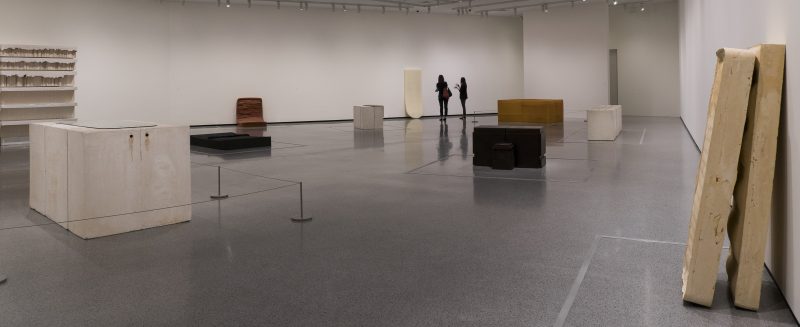
Whiteread employs a conventional format – solid objects that sit on a shelf or stand on the floor, and large, singular forms for public projects; common subjects – everyday structures and objects largely for domestic use; traditional technique – all are cast, in a variety of materials used by other artists; and familiar style – all the work is straightforwardly representational. Whiteread’s work has been exhibited in the usual spaces of galleries, museums, and excepting her first outdoors work, in public spaces chosen by the bodies that commissioned them. What distinguishes them is her artistic intelligence. She has presented a series of ordinary objects, structures and spaces – but in a manner that forces viewers to think of the people who used them and to see them anew.
The British artist and Turner Prize winner came to broad, public attention at the age of thirty with “House” (1993), in which she cast the interior of the last house standing from a row in an area of the East End of London that had been scarred by WWII bombing; the entire terrace was slated for destruction as part of a scheme that involved a park and new highway. By presenting not the walls but the spaces they had formerly enclosed she focused attention on the environment – inside, the series of working-class residents over the course of a century, and outside a public planning project that displaced some people in the name of the greater good. In this case the circumstances attracted endless public attention; much was hostility directed at the municipal planners and changes in real estate use, but responses also questioned the value of Whiteread’s work as art. On the other hand, people flew to London to just see it; when they asked for “that house,” the cabbies knew exactly where to take them.
Disturbing feel of “Ghost,” in which a room is turned inside out
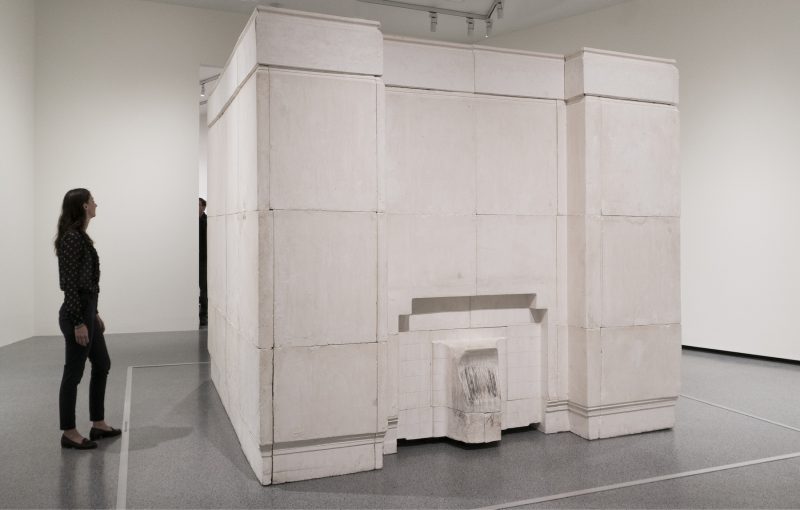
Most of the forms Whiteread has cast (in resin, plaster or concrete) have both interiors and exteriors, and she has made casts of both. “House,” like the structure it recorded, was destroyed, but the NGA exhibition includes “Ghost” (1990), which gives a good sense of her work on an architectural scale. Casting a small room that she was using as a studio in a modest house and retaining the imprint of details such as the fireplace, light switches, double-hung windows and baseboard molding, she turned them inside out to form the exterior of a room-sized block of plaster. The effect is disturbing. That a presumably colored environment is presented in monochrome plaster is already one means of abstraction. But are we inside or outside? If it is a direct cast, why do the moldings protrude from the walls? Or are we seeing the cast result of the mold she made directly from the walls? Is “Ghost” a positive or a negative? Whichever, it carries the aura of space being turned into a solid form. And that is uncanny.
“Closet” and “Torso” and the work’s relation to the body
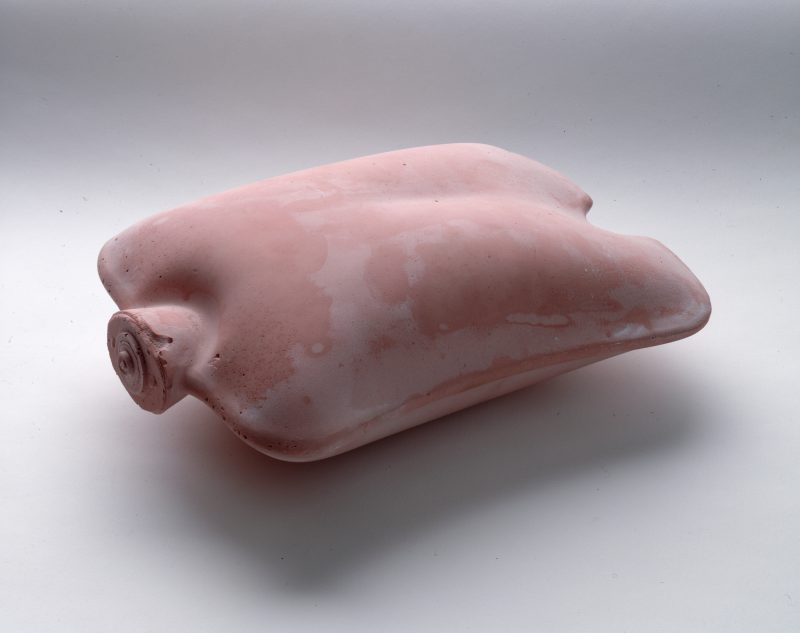
That sense of uncertainty hovers over her work. “Closet” (1990) appears to be a solid, monolithic block, but in fact results from the cast of a wardrobe that has been covered in black felt, with wood replacing the spaces between the exterior doors. A series of small works arranged in a display case are flesh-y in appearance, but turn out to be casts in various materials – plaster, polyurethane, resin and wax – of hot water bottles – soft and giving forms that we may place next to ourselves as we sleep. The artist calls some of them “Torso,” acknowledging the sense of flesh their forms imply. The relation to the body is integral to Whiteread’s work, as she chooses objects and spaces with signs of handling and wear. Many are cast offs, considered useless, such as a sagging mattress leaning against a wall.
The uncanny placement of “Untitled (Domestic),” a staircase on a landing in a stairway
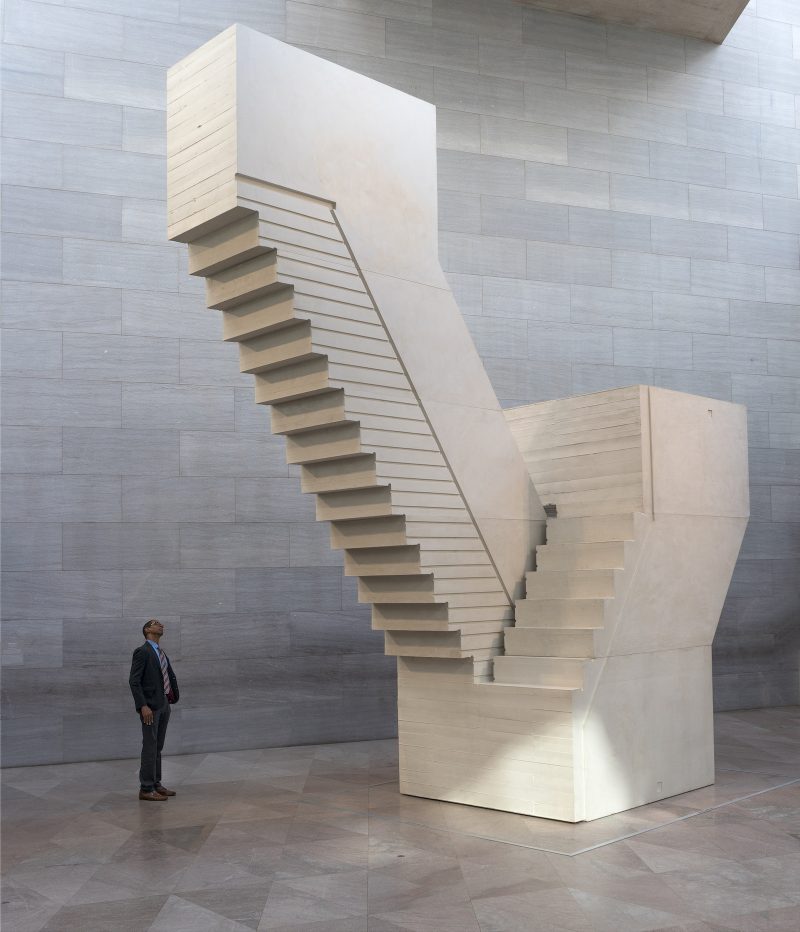
The first work in the exhibition, “Untitled (Domestic)” (2002) is stunningly-sited on a landing leading to the lower-level galleries. It is a staircase, visible in the round as viewers descend first one and then another set of stairs. Staircases famously challenge architects (and draughtsmen such as Piranesi and Escher) with their positive and negative spaces and Whiteread challenges us to read this one, which is a cast turned on its head.
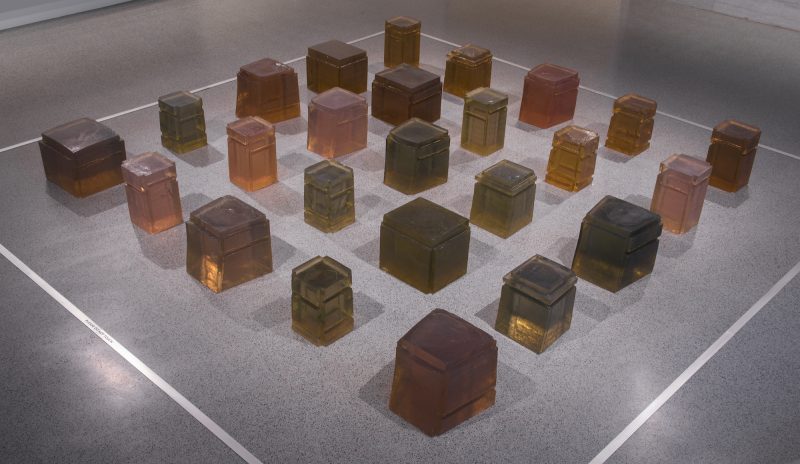
These stairs bring us to one of my favorite works, “Untitled (Twenty-Five Spaces)” (1995) which I first saw a larger variant of at the Carnegie International. The series of multi-color, cast resin forms set on a grid resemble large, jelly candies; they are the spaces underneath a sequence of chairs. Not only are they luminous, translucent objects, but they ask us to think about those ubiquitous spaces that we regularly ignore, and the fact that many spaces around us might have as much aesthetic potential as the objects we call “sculpture.” This provocation is one of several that Whiteread’s work presents. She has done remarkable things with shelves of books, an idea which grew out of her commission for the Holocaust Memorial in Vienna. Two bookcases are in the present exhibition, with colored traces of the books from which they were cast. The books hover over missing shelves, inevitably bringing to mind the many volumes we will never read – and in the case of the Vienna memorial, the many which will never be written by Vienna’s lost Jewish community.
Documentation, collected ephemera, a film and a disappointing placement of 25 Spaces
The exhibition includes studies, photographs, drawings, and a room at the end documenting the public commissions – opposite which is an auditorium that is screening an excellent film about the artist that runs just over an hour. The exhibition also includes a long case with an assortment of objects that the artist scavenges and brings into her studio for inspiration. A wooden last for a high-heeled shoe is emblematic of Whiteread’s interests: a solid form around which a shoe will be created, yielding a cavity to be displaced by a woman’s foot.
My one real disappointment with the exhibition is the installation of “Untitled (Twenty-Five Spaces)” which I mentioned above. I do not think approaching it from an elevated point of view works well, and it emphasizes the metal strips on the floor around it, placed to keep the public away but giving the unfortunate impression that the resin forms are laid out on a carpet. Once sculpture left the pedestal to sit on the floor, it created the necessity for barriers: but museums have struggled to keep them out of the visual field. This was a problem with other works in the exhibition, but none were as compromised as “Untitled (Twenty-Five Spaces)”.
Rachel Whiteread, National Gallery of Art, Located between 3rd and 9th Streets along Constitution Avenue NW, Washington, DC 20001, through Jan. 13, 2019.









